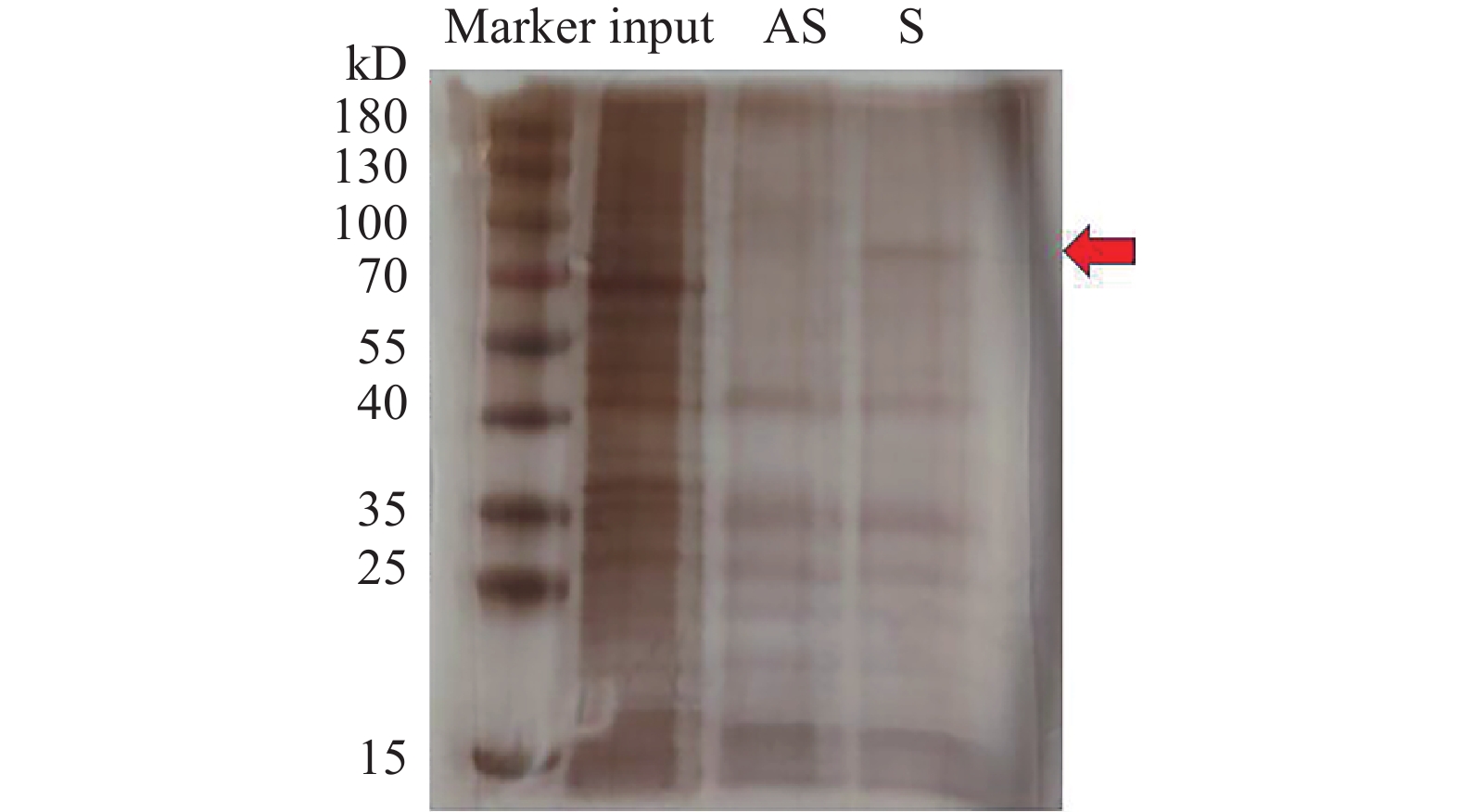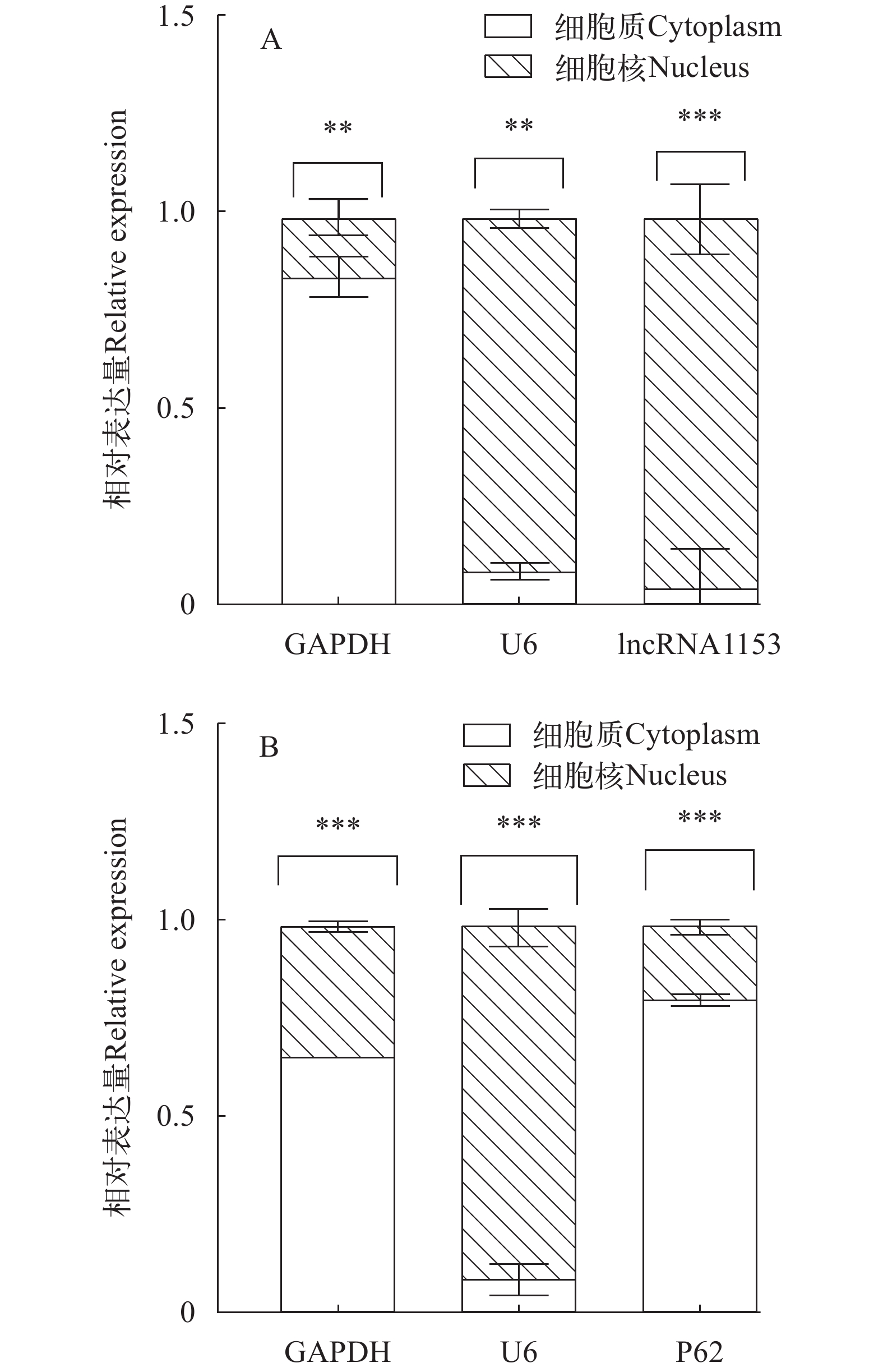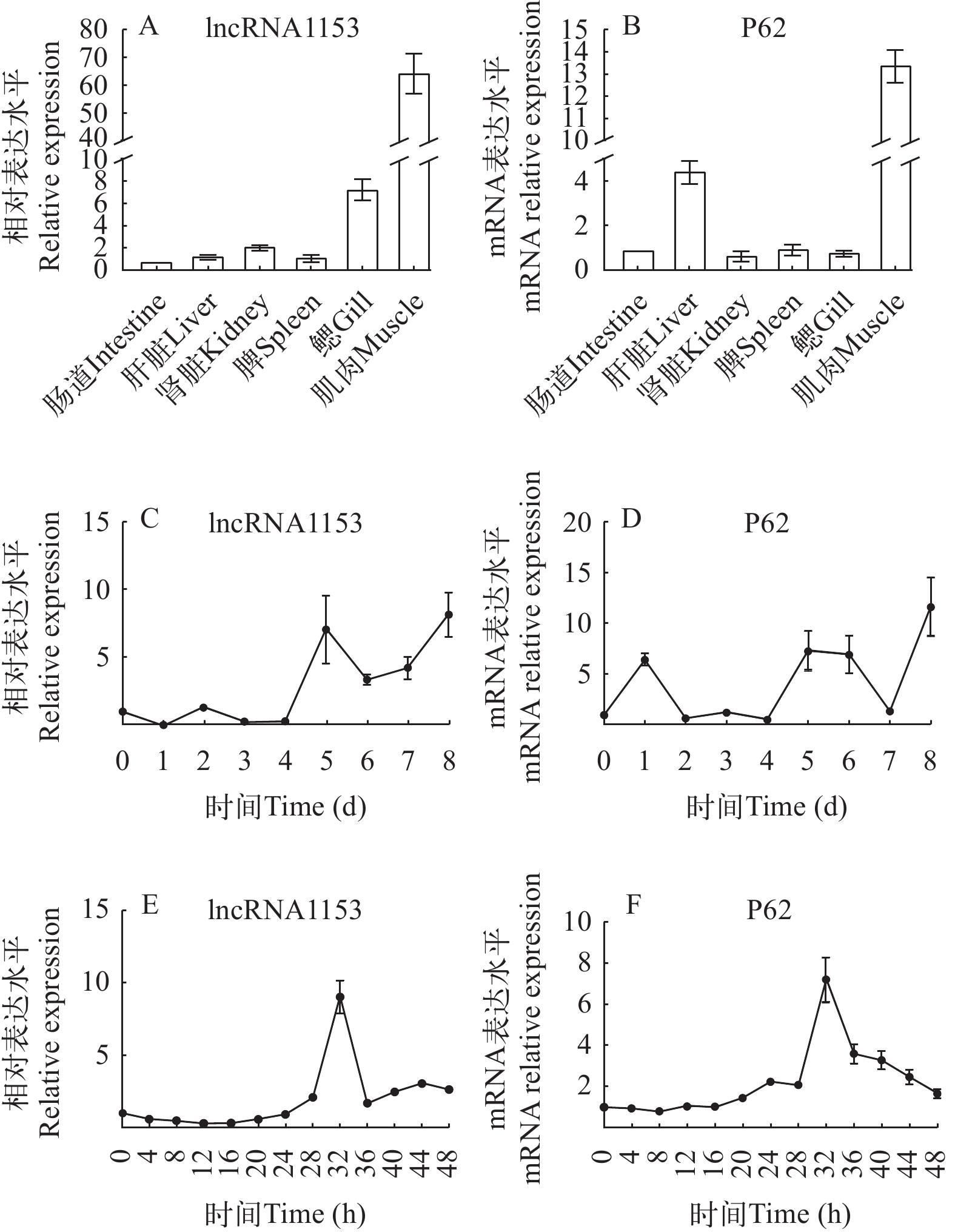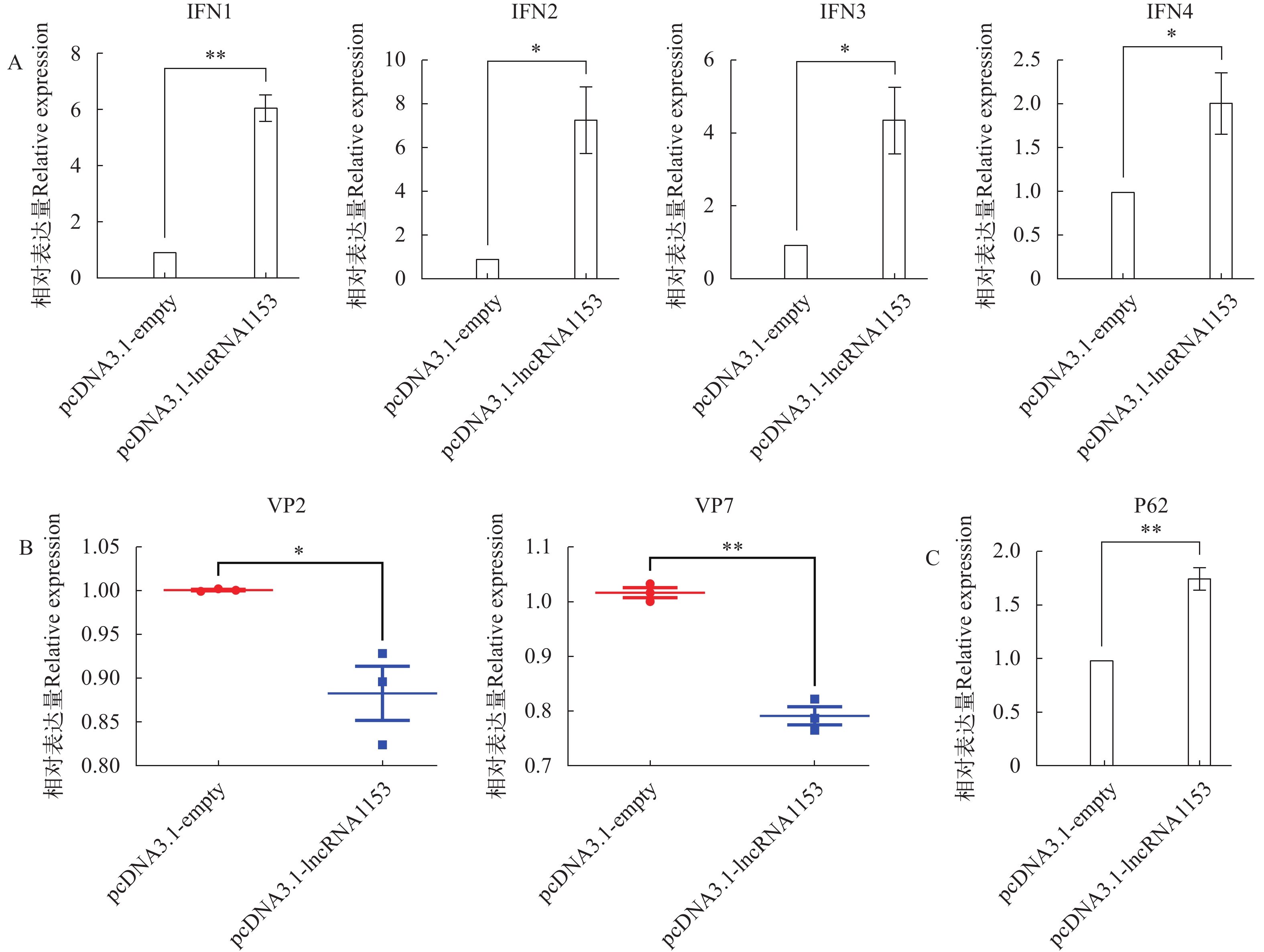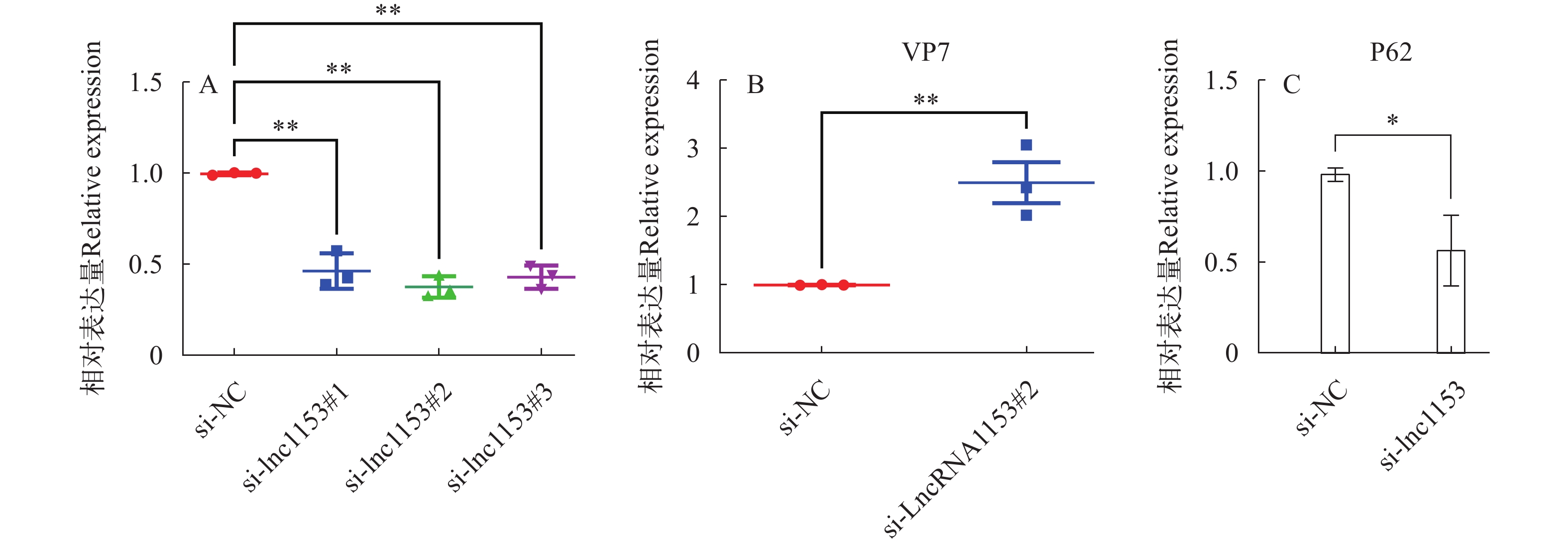FUNCTIONAL ANALYSIS OF LONG NON-CODING RNA1153 IN RESPONSE TO GCRV INFECTION IN GRASS CARP (CTENOPHARYNGODON IDELLA)
-
摘要:
为了解长链非编码RNA在GCRV感染草鱼过程中的分子调控机制, 对GCRV攻毒的草鱼肾脏细胞(CIK)进行长链非编码RNA组学测序, 在此基础上, 筛选出在GCRV攻毒前后差异表达明显的lncRNA1153(PP712057)。利用qRT-PCR技术对lncRNA1153在草鱼CIK细胞中的时空表达水平进行检测, 发现在GCRV感染细胞后, lncRNA1153的表达水平在稳步上升至32h达到峰值。在CIK细胞内对lncRNA进行过表达实验, 发现在lncRNA1153过表达的细胞系中, 在GCRV攻毒后, 干扰素的mRNA表达水平上调。同时, 通过在CIK细胞内进行过表达及RNA pull-down实验, 将富集的蛋白质进行质谱分析, 从中筛选出P62蛋白进行深入研究。qRT-PCR验证发现, 在草鱼肝脏、肾脏等组织及CIK细胞中, lncRNA1153与P62的表达趋势大致相同。进一步的研究发现, GCRV感染CIK细胞后, 过表达lncRNA1153与P62都对GCRV病毒蛋白的复制起到抑制作用。研究表明长链非编码RNA在草鱼拮抗GCRV感染的先天性免疫机制中发挥重要作用, 为未来设计针对GCRV感染的lncRNA靶向治疗提供参考。
-
关键词:
- 长链非编码RNA1153 /
- GCRV /
- CIK细胞 /
- P62 /
- 草鱼
Abstract:Long non-coding RNAs (lncRNAs) are involved in many biological processes including the immune response against virus infection. Based on our previous study, the lncRNA1153 (PP712057) was selected for functional analysis following of GCRV infection in grass carp, both in vivo and in vitro. Quantitative Real-time PCR analysis revealed that lncRNA1153 was expressed in all examined organs, with particularly high level in muscle tissue. Temporal expression analysis in vitro showed a gradual increase in lncRNA1153 expression levels in CIK cells in response to GCRV infection whereas reached a peak at 32h post infection. In addition, in vivo analysis indicated that the expression levels of lncRNA1153 was significantly up-regulated in the kidney starting from 5d post infection, reaching its peak at 8d post infection. Furthermore, overexpression of lncRNA1153 activated several interferon (IFN) promoters and significantly decreased GCRV proliferation, while knockdown of P65 produced opposite effects. We also conducted RNA-protein pull-down assays to analyze lncRNA-protect interactions, identifying P62 as a candidate. Similar to lncRNA1153, P62 was expressed in all examined tissues, particularly at high levels in muscle. Our study suggests that P62 may play a critical role in the innate immune response to GCRV infections. In summary, our research preliminarily explores the innate immune mechanisms of lncRNA1153 in grass carp against GCRV infection.
-
Keywords:
- LncRNA1153 /
- GCRV /
- CIK cells /
- P62 /
- Ctenopharyngodon idella
-
-
图 4 lncRNA1153与P62的表达水平
lncRNA1153 (A)与P62 (B)在草鱼各组织中的表达水平; lncRNA1153 (C)和P62 (D)在草鱼感染GCRV后0—8d的表达变化; GCRV感染CIK细胞后, lncRNA1153 (E)与P62 (F)在0—48h内的表达变化
Figure 4. The expression levels of lncRNA1153 and P62
The expression levels of lncRNA1153 (A) and P62 (B) in various tissues of grass carp; The expression changes of lncRNA1153 (C) and P62 (D) in grass carp infected with GCRV from 0 to 8 after infection; (E) Expression changes of lncRNA1153 (E) and P62 (F) within 0—48h after GCRV infection of CIK cells
图 5 lncRNA1153过表达实验结果图
A. CIK细胞中过表达24h后IFN1-4的表达变化; B. VP2、VP7的表达变化; C. P62的表达变化数据为3个独立实验的平均值±SE, 每个实验1式3份; 使用GraphPad Prism 9.5 (非配对t检验)进行统计分析, P>0.05, *P<0.05, **P<0.01
Figure 5. Results of lncRNA1153 overexpression experiment
A. Changes in IFN1-4 expression after overexpression in CIK cells for 24h; B. Changes in the expression of VP2 and VP7; C. Changes in the expression of P62. Data are shown as mean±SE of three independent experiments, each performed in triplicate; the statistical analysis was performed using GraphPad Prism 9.5 (unpaired t-test), P>0.05, *P<0.05, **P<0.01
图 6 lncRNA1153敲降实验结果图
A. 3种靶向敲低lncRNA1153的siRNA敲低效率对比图; B. 敲低lncRNA1153后VP7的表达情况; C. 敲低lncRNA1153后P62的表达情况数据为3个独立实验的平均值±SE, 每个实验1式3份; 使用GraphPad Prism 9.5 (非配对t检验)进行统计分析, P>0.05, *P<0.05, **P<0.01
Figure 6. Figure of lncRNA1153 knockdown experiment results
A. Comparison of siRNA knockdown efficiency of three targeted knockdown lncRNA1153; B. Knocking down lncRNA1153 results in the expression of VP7; C. Expression of P62 after knocking down lncRNA1153. Data are shown as mean±SE of three independent experiments, each performed in triplicate; the statistical analysis is performed using GraphPad Prism 9.5 (unpaired t-test), P>0.05, *P<0.05, **P<0.01
图 7 P62抗病毒活性实验结果图
A. 相同滴度病毒水平下细胞病变效应结果图; B. TCID50法测定CIK细胞中培养基的病毒滴度; C. 过表达P62后VP2、VP7的表达水平; 数据为三个独立实验的平均值±SE, 每个实验1式3份; 使用GraphPad Prism 9.5 (非配对t检验)进行统计分析, P>0.05, *P<0.05, **P<0.01
Figure 7. P62 antiviral activity experiment results
A. Results of cytopathic effects at the same titer virus level; B. TCID50 method is used to determine the viral titer in the culture medium of CIK cells; C. Expression levels of VP2 and VP7 after overexpression of P62; Data are shown as mean±SE of three independent experiments, each performed in triplicate; the statistical analysis is performed using GraphPad Prism 9.5 (unpaired t-test), P>0.05, *P<0.05, **P<0.01
表 1 实验所用引物及序列
Table 1 Primers and sequences used in this experiment
引物Primer 序列Sequence (5′—3′) GClnc1153-F GGCTGGAAGGCTGTAATAATGG GClnc1153-R CTCCTCTGCAGAACTCTGGT qPCR-GC-β-actin-F AGCCATCCTTCTTGGGTATG qPCR-GC-β-actin-R GGTGGGGCGATGATCTTGAT qPCR-GC-lnc1153-F GGCTGGAAGGCTGTAATAATGG qPCR-GC-lnc1153-R CTCCTCTGCAGAACTCTGGT qPCR-GC-IFN1-F AAGCAACGAGTCTTTGAGCCT qPCR-GC-IFN1-R GCGTCCTGGAAATGACACCT qPCR-GC-IFN2-F TCTTTTTCCTCGTGAATGCTTG qPCR-GC-IFN2-R TCACAACGATGTTCTGACTGGA qPCR-GC-IFN3-F TACATTTATAGAGACTGCGGGTGG qPCR-GC-IFN3-R TGGAGTGTCTGGTAAACAGCCTT qPCR-GC-IFN4-F TCCCTCCATCCTCCTTGTTCA qPCR-GC-IFN4-R GTTCGTCATTCAGGCTCTGGTAG qPCR-GCRV-VP2-F ATCAAGGATCCCATTCCGCCTTCA qPCR-GCRV-VP2-R TTAGAGGATCGTGCCATTGAGGGT qPCR-GCRV-VP7-F ACCACCAACTTTGATCACGCTGAG qPCR-GCRV-VP7-R AGCGTGGGAGTCTTGAATGGTCTT qPCR-GC-P62-F CCCCGATTACGACTTGTGCT qPCR-GC-P62-R TCCTGGTTTTGCTGGTCTCC k-lnc1153-Sense-F TAATACGACTCACTATAGGGGGCTGGAAGGCTGTAATAATGG k-lnc1153-Sense-R GGCGCTTTGTCAGCGCCCTCCTCTGCAGAACTCTGGT k-lnc1153-Antisense-F GGCGCTTTGTCAGCGCCGGCTGGAAGGCTGTAATAATGG k-lnc1153-Antisense-R TAATACGACTCACTATAGGGCTCCTCTGCAGAACTCTGGT 注: GC-β-actin (DQ211096.1)、GC-IFN (DQ357216.1)、VP2 (MT543211)、VP7 (AF403396)、P62 (MK370058.1) 表 2 lncRNA1153互作蛋白相关信息表
Table 2 The information table of interaction protein with lncRNA1153
登录号Accession 基因Gene Mw (kD) Diff Sig A0A5A4CYN7 Keratin 14.636 + A0A7L5BSB8 Sequestosome 1 51.257 + C1KH73 hsp60 42.504 + E7D7N6 HSP70 61.260 + F4YAX3 Tollip 70.594 + I4AY76 Ckbeta 30.491 + A0A076PUA2 SH3 10.695 – A0A0D3R0V5 ADAR1 53.958 – A0A0U2QVN5 prkra 107.239 – A0A142EHR3 tarbp2 32.178 – A0A142EHR4 ADAR2 37.444 – A0A1B3IIH3 Cold inducible RNA 76.999 – A0A2I6QR50 colec12 20.079 – A0A3Q9U464 Glycogen synthase kinase–3 beta 79.987 – A0A4D6K9B0 ppp1c–beta 46.876 – A0A6B9XWC4 Importin alpha 4 31.422 – A0A8K0Y7P9 CNBP 28.060 – B3GN92 RNA helicase 17.983 – C5MR43 EF–1a 72.719 – F8QMS8 Proliferating cell nuclear antigen 45.625 – K4HRD3 Proliferating cell nuclear antigen 18.759 – Q5UBZ7 QM 24.527 – Q7T3N8 rpl15 24.064 – X2IW00 Eukaryotic translation initiation factor 2 36.096 – X2J253 Eukaryotic translation initiation factor 2 36.192 – A0A2S0DT35 Sp1 68.932 – K4MMY6 PKR 77.892 – 注:Accession登录号为差异蛋白在Uni Prot数据库中的登录号; “+”表示呈上调趋势,“–”表示呈下调趋势Note: The Access login number is the login number of the differential protein in the Uni Prot database; “+” indicates an upward trend, “–” indicates a downward trend -
[1] 中国渔业统计年鉴(2022) [M]. 北京: 中国农业出版社, 2022: 24-35.] China Fisheries Statistical Yearbook (2022) [M]. Beijing: China Agriculture Press, 2022: 24-35. [
[2] Wang Q, Zeng W, Liu C, et al. Complete genome sequence of a reovirus isolated from grass carp, indicating different genotypes of GCRV in China [J]. Journal of Virology, 2012, 86(22): 12466. doi: 10.1128/JVI.02333-12
[3] Cheng L, Fang Q, Shah S, et al. Subnanometer-resolution structures of the grass carp reovirus core and virion [J]. Journal of Molecular Biology, 2008, 382(1): 213-222. doi: 10.1016/j.jmb.2008.06.075
[4] Rao Y, Ji J, Liao Z, et al. GCRV hijacks TBK1 to evade IRF7-mediated antiviral immune responses in grass carp Ctenopharyngodon idella [J]. Fish & Shellfish Immunology, 2019(93): 492-499.
[5] Rao Y, Su J. Insights into the antiviral immunity against grass carp (Ctenopharyngodon idella) reovirus (GCRV) in grass carp [J]. Journal of Immunology Research, 2015(2015): 670437.
[6] Mohd Jaafar F, Goodwin A E, Belhouchet M, et al. Complete characterisation of the American grass carp reovirus genome (Genus Aquareovirus: Family Reoviridae) reveals an evolutionary link between aquareoviruses and coltiviruses [J]. Virology, 2008, 373(2): 310-321. doi: 10.1016/j.virol.2007.12.006
[7] Fan Y, Rao S, Zeng L, et al. Identification and genomic characterization of a novel fish reovirus, Hubei grass carp disease reovirus, isolated in 2009 in China [J]. The Journal of General Virology, 2013, 94(Pt 10): 2266-2277.
[8] Pei C, Ke F, Chen Z Y, et al. Complete genome sequence and comparative analysis of grass carp reovirus strain 109 (GCReV-109) with other grass carp reovirus strains reveals no significant correlation with regional distribution [J]. Archives of Virology, 2014, 159(9): 2435-2440. doi: 10.1007/s00705-014-2007-5
[9] Liu M, Xu C, Zhou Y, et al. Biochemical profiling of the protein encoded by grass carp reovirus genotype Ⅱ [J]. iScience, 2024, 27(8): 110502. doi: 10.1016/j.isci.2024.110502
[10] Wu M, Li H, Jiang H, et al. Structure and function of S9 segment of grass carp reovirus Anhui strain [J]. Virusdisease, 2017, 28(1): 26-32. doi: 10.1007/s13337-016-0357-1
[11] Zeng W, Bergmannc S M, Dong H, et al. Identification, virulence, and molecular characterization of a recombinant isolate of grass carp reovirus genotype Ⅰ [J]. Viruses, 2021, 13(5): 807. doi: 10.3390/v13050807
[12] Zeng W, Wang Q, Wang Y, et al. Immunogenicity of a cell culture-derived inactivated vaccine against a common virulent isolate of grass carp reovirus [J]. Fish & Shellfish Immunology, 2016(54): 473-480.
[13] Iyer M K, Niknafs Y S, Malik R, et al. The landscape of long noncoding RNAs in the human transcriptome [J]. Nature Genetics, 2015, 47(3): 199-208. doi: 10.1038/ng.3192
[14] Bridges M C, Daulagala A C, Kourtidis A. LNCcation: lncRNA localization and function [J]. The Journal of Cell Biology, 2021, 220(2): e202009045. doi: 10.1083/jcb.202009045
[15] Schmitz K M, Mayer C, Postepska A, et al. Interaction of noncoding RNA with the rDNA promoter mediates recruitment of DNMT3b and silencing of rRNA genes [J]. Genes & Development, 2010, 24(20): 2264-2269.
[16] Martianov I, Ramadass A, Serra Barros A, et al. Repression of the human dihydrofolate reductase gene by a non-coding interfering transcript [J]. Nature, 2007, 445(7128): 666-670. doi: 10.1038/nature05519
[17] Kuo C C, Hänzelmann S, Sentürk Cetin N, et al. Detection of RNA-DNA binding sites in long noncoding RNAs [J]. Nucleic Acids Research, 2019, 47(6): e32. doi: 10.1093/nar/gkz037
[18] Blank-Giwojna A, Postepska-Igielska A, Grummt I. lncRNA KHPS1 activates a poised enhancer by triplex-dependent recruitment of epigenomic regulators [J]. Cell Reports, 2019, 26(11): 2904-2915.
[19] Liu J, Ji Q, Cheng F, et al. The lncRNAs involved in regulating the RIG-I signaling pathway [J]. Frontiers in Cellular and Infection Microbiology, 2022(12): 1041682. doi: 10.3389/fcimb.2022.1041682
[20] Garcin D. UntRIG(er)ing lncRNAs [J]. Molecular Cell, 2018, 71(1): 6-7. doi: 10.1016/j.molcel.2018.06.026
[21] Bird L. Reigning in RIG-I [J]. Nature Reviews Immunology, 2018, 18(6): 357. doi: 10.1038/s41577-018-0018-2
[22] Jiang M, Zhang S, Yang Z, et al. Self-Recognition of an inducible host lncRNA by RIG-I feedback restricts innate immune response [J]. Cell, 2018, 173(4): 906-919. e13.
[23] Zhang Y, Hu X, Liu S, et al. Identification and analysis of long non-coding RNAs that are involved in response to GCRV infection in grass carp (Ctenopharyngodon idella) [J]. Fish & Shellfish Immunology, 2023(134): 108623.
[24] Zhou M, Wang B, Lin Y, et al. Molecular cloning, functional characterization and expression analysis of P65 subunit in response to GCRV infection in rare minnow (Gobiocypris rarus) [J]. Developmental and Comparative Immunology, 2020(113): 103786. doi: 10.1016/j.dci.2020.103786
[25] Lin Y, Wang B, Wang N, et al. Transcriptome analysis of rare minnow (Gobiocypris rarus) infected by the grass carp reovirus [J]. Fish & Shellfish Immunology, 2019(89): 337-344.
[26] Kremer M, Volz A, Kreijtz J H C M, et al. Easy and efficient protocols for working with recombinant vaccinia virus MVA [J]. Methods in Molecular Biology, 2012(890): 59-92.
[27] Ma J, Zeng L, Fan Y, et al. Significant inhibition of two different genotypes of grass carp reovirus in vitro using multiple shRNAs expression vectors [J]. Virus Research, 2014(189): 47-55. doi: 10.1016/j.virusres.2014.05.009
[28] Zhang Q, Gui J F. Virus genomes and virus-host interactions in aquaculture animals [J]. Science China Life Sciences, 2015, 58(2): 156-169. doi: 10.1007/s11427-015-4802-y
[29] Kumar A V, Mills J, Lapierre L R. Selective autophagy receptor p62/SQSTM1, a pivotal player in stress and aging [J]. Frontiers in Cell and Developmental Biology, 2022(10): 793328. doi: 10.3389/fcell.2022.793328
[30] Cuyler J, Murthy P, Spada N G, et al. Sequestsome-1/p62-targeted small molecules for pancreatic cancer therapy [J]. Drug Discovery Today, 2022, 27(1): 362-370. doi: 10.1016/j.drudis.2021.09.011
[31] Deng T, Hu B, Wang X, et al. TRAF6 autophagic degradation by avibirnavirus VP3 inhibits antiviral innate immunity via blocking NFKB/NF-κB activation [J]. Autophagy, 2022, 18(12): 2781-2798. doi: 10.1080/15548627.2022.2047384
[32] Xie W, Tian S, Yang J, et al. OTUD7B deubiquitinates SQSTM1/p62 and promotes IRF3 degradation to regulate antiviral immunity [J]. Autophagy, 2022, 18(10): 2288-2302. doi: 10.1080/15548627.2022.2026098
[33] Wu Y, Jin S, Liu Q, et al. Selective autophagy controls the stability of transcription factor IRF3 to balance type Ⅰ interferon production and immune suppression [J]. Autophagy, 2021, 17(6): 1379-1392. doi: 10.1080/15548627.2020.1761653
[34] Jiang L Q, Xia T, Hu Y H, et al. IFITM3 inhibits virus-triggered induction of type Ⅰ interferon by mediating autophagosome-dependent degradation of IRF3 [J]. Cellular & Molecular Immunology, 2018, 15(9): 858-867.
[35] Prabakaran T, Bodda C, Krapp C, et al. Attenuation of cGAS-STING signaling is mediated by a p62/SQSTM1-dependent autophagy pathway activated by TBK1 [J]. The EMBO Journal, 2018, 37(8): e97858. doi: 10.15252/embj.201797858
[36] Huang S, Hendriks W, Althage A, et al. Immune response in mice that lack the interferon-gamma receptor [J]. Science, 1993, 259(5102): 1742-1745. doi: 10.1126/science.8456301



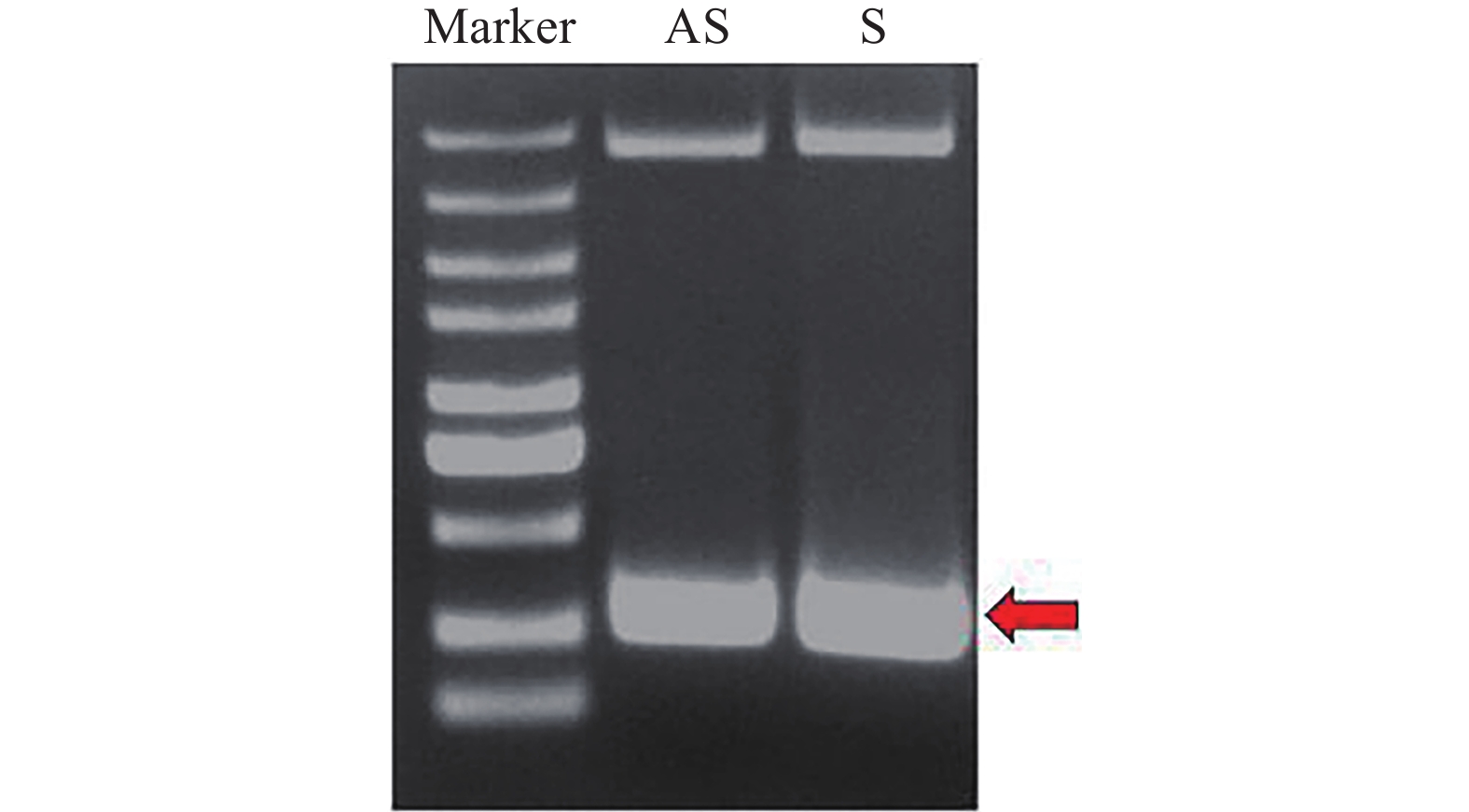
 下载:
下载:
